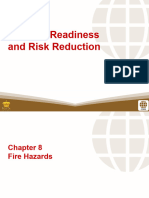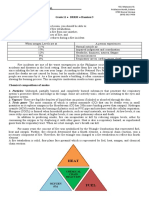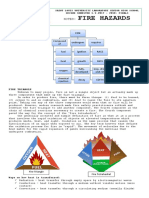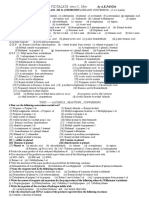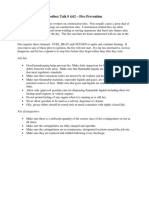DRRR Q2 W4 Mod
Uploaded by
laylaynelaDRRR Q2 W4 Mod
Uploaded by
laylaynelaDisaster Readiness and Risk Reduction
QUARTER 2 MODULE 4 WEEK 4
Learning Competencies (Essential Competencies)
● Recognize elements of the fire triangle in different situationsDRR11/12-IIe-f-37
● Analyze the different causes of firesDRR11/12-IIe-f-38
DAY 1: Fire
Objectives
● Describe fire
● Recognize elements of the fire triangle in different situations
Introduction:
Figure 1: Disaster Risk
Figure 1: Cooking with fire Figure 2: Star City as it is being destroyed
"Kolbullar @ Gregoriemarknaden 2013" by by fire
Larsfl is licensed under CC BY-SA 2.0 By: Philstar.com
We usually hear or watch news about destructive fires. We are aware that fire is dangerous
and can cause severe damage and destruction and, at times, death. Since the beginning of
time, humans have tried to find out what fire is, how it starts, and what keeps it going.
Let’s Recall (Review)
Directions: Using the column below write down the positive (pros) and negative
(cons) qualities of fire on the space provided
Positive Qualities of Fire (Pros) Negative Qualities of Fire (Cons)
1. _______________________________ 1. _______________________________
2. _______________________________ 2. _______________________________
3. _______________________________ 3. _______________________________
4. _______________________________ 4. _______________________________
5. _______________________________ 5._______________________________
1
Let’s Understand (Study the Concept)
What is fire?
Fire is a rapid, self-sustaining oxidation process of combustible materials accompanied by
the evolution of heat and light of varying intensity
FIRE IS ...
a. FAST - Fire spreads quickly; there is no time to gather valuables or make a phone
call. In just two minutes a fire can become life-threatening. In five minutes a
residence can be engulfed in flames.
b. DARK - A small fire can produce enough smoke to fill a building in minutes.
c. DEADLY - Most people who die in fires die from breathing smoke and toxic gases.
Fire produces poisonous gases that make you disoriented and drowsy. (carbon
dioxide, nitrogen oxide, and carbon monoxide)
Physiological Effects of Reduced Oxygen (Hypoxia)
Oxygen in Air (Percent) Symptoms
21 None – Normal Conditions
17 Some impairment of muscular
coordination; increase in respiratory
rate to compensate for lower oxygen
content
12 Dizziness, headache, rapid fatigue
BASIC FIRE SCIENCE
9 Unconsciousness
6 Death within a few minutes and
concurrent heart failure
d. HOT - hot enough to burn clothes, skin and scorch your lungs in one breathe
(Mangaoang, 2017)
Figure 3: Fire Triangle Figure 4: Fire Tetrahedron
Fire Triangle and
Fire Tetrahedron
2
For several years the concept of fire was represented by the Fire Triangle which is
composed of heat, fuel, and oxygen. Further fire research determined that a fourth element,
a chemical chain reaction, was a necessary component of fire. The fire triangle was changed
to a fire tetrahedron to reflect this fourth element. A tetrahedron can be described as a
pyramid which is a solid having four plane faces. Essentially all four elements must be
present for fire to occur, fuel, heat, oxygen, and a chemical chain reaction. Removal of any
one of these essential elements will result in the fire being extinguished. (Fire Safety, 2016)
Fuel - any kind of combustible material, including paper, oils, wood, gases, fabrics, liquids,
plastics, and rubber. The factors that determine how easily, how fast, and in what
temperature a fuel will burn are usually based on different characteristics such as its
moisture content, size, shape, and quantity fuel will burn and at what temperature.
Oxygen - a type of gas commonly found in the air. Air contains about 21% oxygen, and most
fires require at least 16% oxygen content to burn. Oxygen supports the chemical processes
that occur during fire. When fuel burns, it reacts with oxygen in a process known as
oxidation.
Heat - A heat source is responsible for the initial ignition of fire, and is also needed to
maintain the fire and enable it to spread. Heat allows fire to spread by drying out and
preheating nearby fuel and warming surrounding air.(Smokeybear,2020)
Three methods of heat transfer
1. Conduction
-heat conducted from one body to another either by direct contact of by an
intervening heat conducting medium
- depends on the type of conductor: metal (good), drywall (poor)
-example:metal plumbing components or electrical conduit
2. Convection
-transfer of heat energy by movement of air or liquid
-heated gases rise:mushrooming
-examples: Fire traveling through elevators shafts, stairways, balloon frame walls
3. Radiation
-Transfer by heat waves
-Travels through space until it reaches an opaque object
-Major source of fire spread to exposures (Mangaoang, 2017)
Let’s Apply
Directions: Answer the following questions. Write your answer on your answer sheet.
1. What are the components needed for fire to occur? Explain each using your own words
2. What makes fire dangerous?
Let’s Analyze
Directions: Copy the table below on your answer sheet and complete it by
filling out the components of fire triangle in the following scenarios.
Fuel Heat Oxygen
Campfire
Cooking food using
3
gas stove
Lighter used for
lighting cigarettes
Electrical fires during
summers
DAY 2: Causes of Fire
Objectives
● Analyze the different causes of fires and describe the different
stages of fire
Introduction:
BFP: More fires, more deaths reported in 2019
Romina Cabrera (The Philippine Star) - December 13, 2019 - 12:00am
MANILA, Philippines — The Bureau of Fire Protection (BFP) has reported an increase in the
number of fires and deaths for this year compared to 2018.
Latest BFP data showed that there were 16,382 fires in the country from Jan. 1 to Dec. 11, a
three-percent increase from 15,848 incidents in the same period last year.
The number of civilians who died in fires also rose by nine percent to 326 persons. Four BFP
personnel also died while on duty.
In the National Capital Region alone, 92 civilians died in the 4,352 fires reported this year.
The number of injured dropped to 930 civilians and 58 personnel in 2019 from 326 people
and 84 personnel last year.
The BFP noted that the top three causes of fires are still the same, with faulty electrical
connections as the leading cause.This was followed by lighted cigarette butts and open
flames due to torches or sulo. (Cabrera, 2019)
Let’s Recall (Review)
Directions: Answer the following questions. Write your answer on your
answer sheet.
1. How many reported fire incidents happened last year (2019) in the
Philippines? __________________________________________________
2. What are the top three causes of fires? _____________________________
Let’s Understand (Study the Concept)
Causes of fire as listed in the Bureau of Fire Protection Operational Procedures
Manual:
A. Faulty electrical wiring or connection
B. LPG-related
C. Neglected cooking or stove
D. Cigarette butt
E. Unattended open flame: torch or sulo
F. Unattended open flame: candle or gasera
G. Matchstick or lighter
H. Direct flame contact or static electricity
I. Neglected electrical appliances or devices
J. Electrical machineries
K. Chemicals
4
L. Incendiary device or ignited flammable liquid
M. Spontaneous combustion
N. Fireworks (Pyroclastics)
O. Bomb explosion
P. Lightning
Q. Others (forest fire, vehicular fire, etc.) (Bagtasa, 2016)
Stages of fire
1. Ignition Stage
Point wherein the fire starts
There is plenty of oxygen, little heat and smoke
Fire is still small and generally confined to the fuel that initially ignited
2. Growth Stage
Temperature and smoke level increases
Oxygen level decreases and the fuel is already dried out
Hot gases rise to the ceiling and spreads outward the walls
Can be continuous if there is enough fuel and oxygen
The smoke layer is getting thicker and fire is starting to spread to nearby furniture
3. Flash Over
Transition between growth and fully developed stage
Presence of huge smoke which indicates the rapid change of situation
May involve exposed combustibles
Increasing level of smoke with decreased visibility
Gases are generated by heat
4. Fully developed
All combustible materials present are continuously burning
Maximum amount of heat is released
The volume of fire is dependent of the number and size of ventilation openings
Unburned gasses begin flowing to adjacent spaces and ignite once it enters the
space where air is more abundant
5. Decay
Intensity of fire decreasing due to lack of available fuel
Most of fuel consumed
Effort concentrated on cooling of the remaining fuel (Mangaoang, 2017)
Let’s Apply
Directions: Determine the most common causes of fire in the following places
1. House: _______________________________________________________
2. School: _____________________________________________________________
3. Computer shop: ______________________________________________________
4. Forest: ____________________________________________________________
5. Grocery store: ________________________________________________________
Let’s Analyze
Directions: Answer the following questions. Write your answer on your answer
sheet.
1. Give the importance of knowing the different stages of fire. ________________________
2. Which among the causes of fire is the most common in your place? Suggest ways on how
you can avoid/prevent it.______________________________________________________
5
DAY 3: Classification of Fire
Objectives
● Describe Extinguishment theory and explain the different ways to
extinguish fire
● Classify fire based on its fuel
Introduction:
The pictures above show different objects on fire. Fire can be classified based on the type of
fuel being consumed. The concept is usually used as a basis on how to extinguish it.
Let’s Understand (Study the Concept)
Fire Extinguishment theory-these are things that you can do to extinguish or put off the fire. It
is based on removing any one or more of the four elements in the fire tetrahedron to suppress
the fire.
1. Reduction of temperature (also known as cooling)
Removing heat is one of the most effective ways to extinguish fire. This can be done by
using something that absorbs heat like water which is known as the best cooling agent.
Remember: It is not advisable to use water to extinguish grease fire (fire caused by oil
or fats) or electrical fire.
2. Exclusion or deprivation of oxygen (also known as smothering)
Another way to extinguish fire is by removing the oxygen. This can be done in many
ways like putting sand, blanketing, foam application or by the use of chemical
extinguishers.
3. Removal of fuel (also known as starvation)
This is achieved by removing the fuel burning in the fire. Flammable liquid or gas fire
can be extinguished by shutting off the fuel supply.
4. Inhibition of chain reaction or breaking the combustion chain
This can be done by doing at least one of the methods mentioned above(cooling,
smothering or starvation).
Classification of fire
Fires are classified based on the type of material being burned (fuel). This classification is utilized
to determine the right extinguishing agent to be used to put out the fire . Listed below are the
different classification of fire:
Class A – fuels are ordinary combustibles or fibrous material such as wood, paper, plastic, or
anything that leaves ash.
Class B – fuels are flammable or combustible liquids like petroleum oil, gasoline, paint, and
flammable gasses such as propane and butane. Cooking oils and grease are NOT part of class
B fires.
6
Class C – fuels are energized electrical fires like motors, transformers, and appliances. Once the
power or source of electricity is removed, the fire becomes one of the other classes of fire.
Class D – fuels are combustible metals like potassium, sodium, aluminum, titanium, and
magnesium. They may react violently with water or other chemicals, and must be handled with
care
Class K – fuels are cooking oils, grease such as animal fat and vegetable fats. (Bagtasa, 2016)
Let’s Apply
Determine the type of fire found in the following
1. Burning a pile of leaves: ______________________________________
2. Fire created due to overloading of christmas lights __________________
3. A burst of fire produced after you accidentally add water to oil while frying ________
4. Fire produced by gas stoves ___________________________________________
5. Fire in a plastic factory
___________________________________________________
Let’s Analyze
What is the importance of knowing the different types of fire?
_________________________________________________________________________
_________________________________________________________________________
DAY 4: Evaluation
Objective
Apply knowledge about the classification, stages and elements of fire
I. Identification. Directions: Write the best answer on the space provided.
____________1. Point wherein the fire starts
____________2. Any kind of combustible material
____________3. Stage where most of fuel consumed
____________4. Responsible for the initial ignition of fire
____________5. Transfer of heat energy by movement of air or liquid
____________6. Stage where the maximum amount of heat is released
____________7. Stage where the temperature and smoke level increases
____________8. A type of gas commonly found in the air which supports the chemical
processes that occur during fire.
____________9. Stage characterized by the presence of huge smoke which indicates the
rapid change of situation
____________10. A rapid, self-sustaining oxidation process of combustible materials
accompanied by the evolution of heat and light of varying intensity]
II. Directions: Classify the following materials based on the type of fire they can
create.
____________1. Appliances ____________9. Butane
____________2. Cooking oils ____________10. Gasoline
____________3. Paper ____________11. Plastic
____________4. Petroleum oil ____________12. Paint
____________5. Propane ____________13. Sodium
____________6. Potassium ____________14. Transformers
____________7. Magnesium ____________15. Wood
____________8. Vegetable fats
7
III. Enumeration Directions: Answer the following questions. Write your answer on the
space provided.
1-4. What are the 4 ways to extinguish fire based on the extinguishment theory?
1.____________________________________________________________
2.____________________________________________________________
3.____________________________________________________________
4. ____________________________________________________________
5-8. What are the 4 elements needed for fire to occur based on the fire tetrahedron?
5.____________________________________________________________
6.____________________________________________________________
7.____________________________________________________________
8.____________________________________________________________
You might also like
- Grade 4 Science Weeks 1-6 Worksheets - Term 3100% (1)Grade 4 Science Weeks 1-6 Worksheets - Term 343 pages
- LEARNING MODULE - SPECIALIZED - DISASTER READINESS AND RISK REDUCTION - MODULE 2 - Q2 - WK3 To WK4 OKNo ratings yetLEARNING MODULE - SPECIALIZED - DISASTER READINESS AND RISK REDUCTION - MODULE 2 - Q2 - WK3 To WK4 OK3 pages
- 1 Basics of Fire With The Fire Triangle NOTESNo ratings yet1 Basics of Fire With The Fire Triangle NOTES26 pages
- Notes in Fire Technology Arson InvestigationNo ratings yetNotes in Fire Technology Arson Investigation4 pages
- Disaster Readiness and Risk Reduction: Quarter 2 Week 4No ratings yetDisaster Readiness and Risk Reduction: Quarter 2 Week 416 pages
- Fire Protection and Arson Investigation PRELIM NOTES100% (1)Fire Protection and Arson Investigation PRELIM NOTES22 pages
- Providential Fires Are Caused by Act of God, Like LightningNo ratings yetProvidential Fires Are Caused by Act of God, Like Lightning3 pages
- Module - 4: 18 ARC 63 Building Services IIINo ratings yetModule - 4: 18 ARC 63 Building Services III18 pages
- Chapter-8-Fire-Hazards-and-Related-Concepts-1No ratings yetChapter-8-Fire-Hazards-and-Related-Concepts-15 pages
- CVS 467chapter 3 Fire Danger and Protection - 231025 - 070408No ratings yetCVS 467chapter 3 Fire Danger and Protection - 231025 - 07040837 pages
- Polynuclear Aromatics: Anthracene Naphthalene0% (1)Polynuclear Aromatics: Anthracene Naphthalene26 pages
- Fire Protection and Arson Investigation Q and ANo ratings yetFire Protection and Arson Investigation Q and A7 pages
- Kendriya Vidyalaya Nmo-3, BBSR: by A.K.PANDA100% (3)Kendriya Vidyalaya Nmo-3, BBSR: by A.K.PANDA2 pages
- Disaster Risk Readiness and Reduction Module 9 - The Elements of Fire Triangle What'S inNo ratings yetDisaster Risk Readiness and Reduction Module 9 - The Elements of Fire Triangle What'S in4 pages
- Fractional Distillation - Ojasvi Singh 11 s1No ratings yetFractional Distillation - Ojasvi Singh 11 s110 pages
- CHAPTER 2 & 3 - Fire Technology and Arson InvNo ratings yetCHAPTER 2 & 3 - Fire Technology and Arson Inv32 pages




